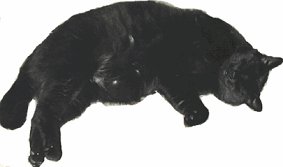

 | knowyourcat.info |

Have you ever heard the owner of a pet saying 'I wish I knew what he wanted' or 'what she is thinking'?
Well the fact is that our pets talk to us all the time. We just need to learn what they are trying to say. Cats don't vocalize much, although they have a vocabulary of sounds. Their main communication is through body language. Actually, cats use sound mostly to communicate with humans, and much less with other animals.
Meowing is probably something cats learn. We talk to our furry friends all the time, so they too have developed a 'voice' to express themselves to us.
We won't spend too much time on the subject of cat's vocalization, but I it is important to briefly mention three or four sounds.
A standard 'Meow' is a general signal that a cat wants our attention. Sometimes cats wanting attention will politely 'meow' almost without making any sound at all (though ignoring this may lead to a rapid escalation in sound levels!).
A quick 'chirrip' meow is a greeting. The well known 'purr' usually means 'I am content and happy'. But we should remember that a cat will also purr when it is in pain. Cats purr when they are emotional; whether happy or in distress - in some ways purring is also a way to seek attention and aid.
'Hisses' and 'growls' are used when a cat is threatened and challenged. This is the cat's way to warn others to back off - and this is not a good time to approach and pat the cat, even to reassure it. The hiss and growl may not be directed toward you, but the cat may release her aggression by snapping at your hand.
Most of a cat's communication is through body language. Ears, tail, legs, posture and eyes are all talking, giving us and other members of the animal kingdom clear messages
By observing cats in the wild, and domestic cats under different conditions, experts have learned a lot about the body language of cats. But there is no doubt that there are much more subtle signals which we have not discovered yet. So just as cats watch and try to understand us, we should watch them and learn.
The description which we included below is by no means a full set and I am sure that we will be adding some new material as we learn more about our furry friends. (And remember, just as with humans, body language can vary among individuals - so the secret is - Know Your Cat!)
Posture
Since we are talking about body language, let's start with general posture. An upright posture with the head held high indicates a confident and content cat. When the cat lowers her head and turns it sideways, avoiding eye content it indicates lack of interest and non-aggression.
In the presence of danger (e.g. a strange cat trespassing on their territory), the cat's head will move down and her back will start arching, getting ready to attack if the need arises. Some cats will lower themselves to the ground with their front paws in before them and back legs firmly underneath.
When a cat is hunting it will start by quietly lying down with the forelegs in front and the back legs under the body. As she is getting ready to jump on the prey, her backside goes up with the head almost flat on the ground. The cat's head will move from side to side to get a better feel for the exact distance between her and the prey.
A very relaxed cat will lie on her side or back with legs spread outwards. You almost never see a cat in this position if the cat is not fully at home with her surroundings. This is also an indication that the cat may allow you to stroke her tummy. It is a sign of trust.
Ears

Attentive - ears pointed, whiskers straight
A cat's ears are very mobile. Cats have over 20 muscles controlling them and they can literally turn the ears through 180 degrees. The position of the ears are a very good indication of cat's mood.
The ears straight up slightly facing forward and the whiskers relaxed are the signs of a happy and alert cat. If you now start stroking her the whiskers may move slightly forward, and the eyes will half close - this with a soft purr will tell you that she is a very content cat.
When the cat is nervous the ears will start moving sideways and the whiskers will drop down. As the cat starts feeling more uneasy the ears will start moving further back. An angry and frightened cat will put her ears flat facing sideways or back. It is not unusual for a nervous cat to trot away with her ears turned back 'facing' the threat as a kind of early warning system.
Of course the movement of the ears is not always an indication of cat's mood. After all, the ears are mainly for listening. So the cat will turn her ears towards the incoming sound.
Because the ears can move independently you can often see one ear facing forward as the other moves sideways to get a better reception.
Want more? Go to Body Language Part II
 |

